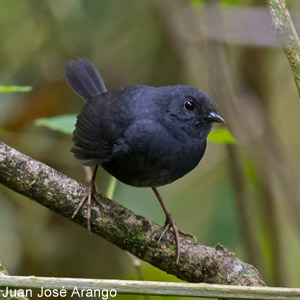Magazine | Études
Description d’une nouvelle espèce d’oiseau, le Mérulaxe de Stiles

Mérulaxe de Stiles (Scytalopus stilesi), reserva La Romera, Sabaneta, département d’Antioquia (Colombie).Photographie : Juan José Arango / Sa galerie sur Flickr
Introduction
2005 est une année riche en émotion ornithologiques : après l’annonce de la redécouverte du Pic à bec d’ivoire aux États-Unis, après celle de la découverte du Grisin de São Paulo au Brésil, des scientifiques colombiens, américains et danois viennent de publier en avril la première description d’un passereau dans la Cordillera Central en Colombie appelé Mérulaxe de Stiles (Scytalopus stilesi). L’aire de distribution de cette espèce s’étend dans la moitié nord de cette chaîne de montagne, dans des forêts nébuleuses situées entre 1 420 et 2 130 mètres d’altitude. Les vocalises se distinguent distinctement de celles de tous les autres taxa connus du genre Scytalopus.
Dans cet article publié en avril dans la revue The Auk, Andrès M. Cuervo, Carlos Daniel Cardena, Niels Krabbe et Louis Miguel Rengifo décrivent cette espèce nouvelle pour la science, les méthodes d’analyses utilisées et son statut.
Abstract
Andrès M. Cuervo, Carlos Daniel Cardena, Niels Krabbe and Louis Miguel Rengifo described in 2005 in the The Auk journal a new species of tapaculo endemic to Colombia they named Scytalopus stilesi on the basis of a series of eight specimens taken in 2002 and comparative analyses of its vocalizations, mitochondrial DNA sequences, and distribution.
The new species ranges in the northern half of the Cordillera Central of the Colombian Andes in the Departments of Antioquia, Caldas, and Risaralda, in cloud forests between 1,420 and 2,130 m above sea level. The song, calls, and female song of the new species differ distinctly from those of all other known Scytalopus taxa. Phylogenetic analyses based on sequences of the cytochrome-b gene strongly suggest affi nities with S. robbinsi of southwestern Ecuador and with two as-yetundescribed tapaculos from the Colombian Andes. Scytalopus stilesi coexists locally with, though it is ecologically segregated from S. atratus, S. latrans, and S. spillmanni.
The mid-elevation premontane wet forests to which the new species is restricted have been subject to severe deforestation and fragmentation. The species is, however, relatively common in continuous mature-forest remnants, large primary-forest fragments, riparian forests, and tall secondary-forest patches. We employed a geographic information system (GIS) approach to model the potential distribution of the new species and assess its conservation status under the International Union for the Conservation of Nature (IUCN) criteria. Scytalopus stilesi does not qualify as threatened according to those criteria, but it should be regarded as near threatened.
The new species coexists with numerous threatened bird species that are in need of more effective conservation.
Poursuivez la lecture de cet article, en vous abonnant dès maintenant !
Découvrez les Archives d’Ornithomedia.com
Pour seulement 10,00 €TTC/an (ou 6,00 € les 6 mois)
Profitez de plusieurs centaines d’articles en accès illimité et sans aucun engagement.
Compléments
À lire aussi sur Ornithomedia.com
- Description d’une nouvelle espèce d’oiseau, le Mérulaxe de la Perijá
- Reconnaissance d’une nouvelle espèce d’oiseau au Brésil, le Mérulaxe de Gonzaga
- Description d’une nouvelle sous-espèce du Mérulaxe de Rodriguez
- Pete Hosner et la découverte du Mérulaxe de Junín ou de Getty
- Description d’une nouvelle espèce d’oiseau au Pérou, le Mérulaxe de Junín ou de Getty
- Description d’un nouveau taxon, le Mérulaxe des rochers
- Découverte d’une nouvelle sous-espèce du Mérulaxe du matorral
- Révision de la taxonomie du Mérulaxe du páramo
Source
Andrès M. Cuervo, Carlos Daniel Cardena, Niels Krabbe and Louis Miguel Rengifo (2015). Scytalopus stilesi, a new species of tapaculo (Rhinocryptidae) from the Ccordillera Central of Colombia. The Auk. Volume 122. Numéro 2. Pages : 445-463




Aucun commentaire sur ce sujet
Participer à la discussion !